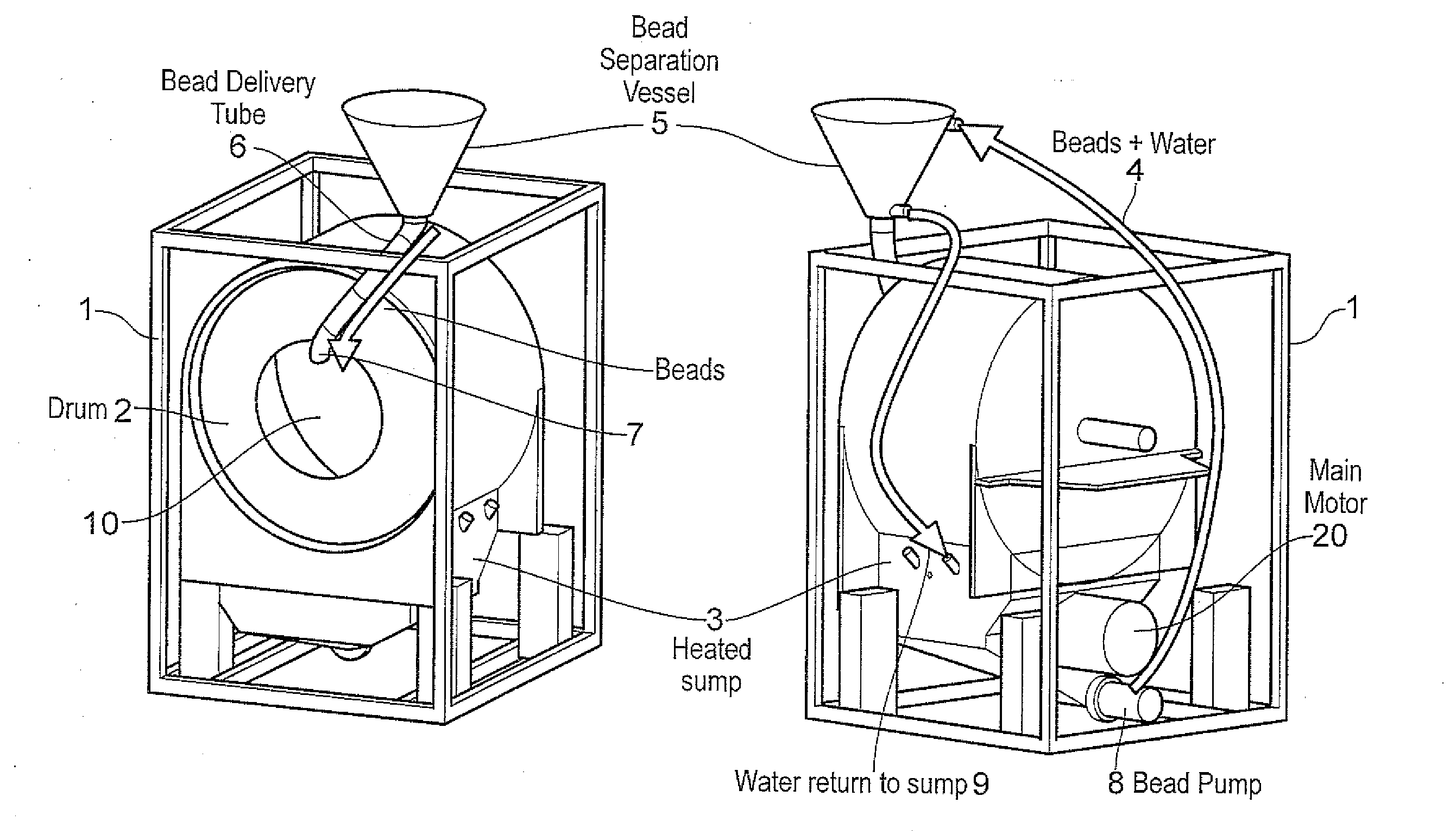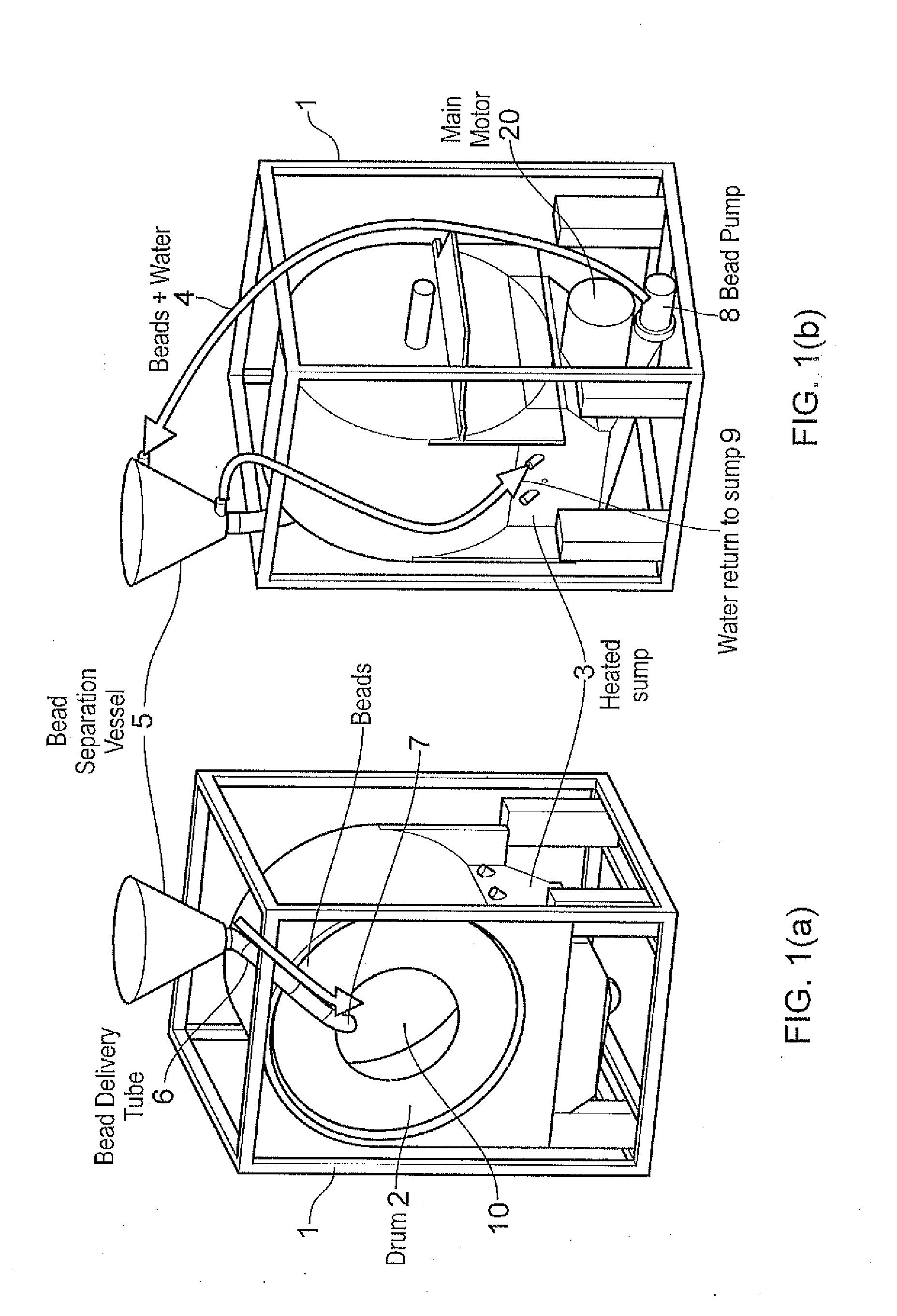Polymer treatment method
a technology of polymer and treatment method, which is applied in the preparation of detergent mixture composition, cleaning using liquids, detergent compounding agents, etc., can solve the problems of increasing the difficulty of reducing water (and hence energy and detergent) levels in a pure aqueous process, affecting the environment, and consuming water, so as to facilitate the efficient transfer of at least one cleaning material to the substrate, improve the transport properties of the system, and facilitate the removal of soiling and stains from the substra
- Summary
- Abstract
- Description
- Claims
- Application Information
AI Technical Summary
Benefits of technology
Problems solved by technology
Method used
Image
Examples
example 1
[0071]Two fabric cleaning cycles were carried out using an apparatus as described in WO-A-2011 / 098815. This apparatus was based on a 50 kg Sea Lion industrial washer-extractor, modified to run with polymeric particles and, hence, it additionally comprised a second chamber, pumping means, separating means, and rotatably mounted cylindrical cage, as described in WO-A-2011 / 098815. The polymeric particles were polyethylene terephthalate (polyester) grade 1101 E, as supplied by INVISTA, Gersthofen, Germany. The mass of particles in the apparatus was 50 kg. Both fabric washing cycles cleaned very highly soiled car mechanics' overalls—20.8 and 20.0 kg washloads respectively, as supplied by Watford Launderers, London, UK. The cycles were both run at wash temperatures of 65° C., with a 35 minute wash, followed by three rinses each of 10 minutes, whilst using the following fabric cleaning agents, added sequentially throughout the fabric cleaning cycle as shown:[0072]a) 465.0 g Selox Mild—Chri...
example 2
[0098]The efficacy of the particle cleaning formulation of Table 1 was further evaluated. Thus, polymeric particles were pre-soiled by taking 12 kg of virgin 1101E particles, and adding to this the residual liquor from boiling 12 SBL2004 sebum cloths (WFK) in 3 litres of water for 30 minutes, 700 g of tomato ketchup (Heinz), 200 g of instant coffee powder (Morrisons, Value Range), 440 g of curry sauce (Morrisons, Value Range), 1200 g of motor oil (Halfords) and, finally, a further 9 litres of water. This mixture was left at room temperature for three weeks, and stirred for 30 minutes each day over that period.
[0099]Industry recognised stain sets (WFK Standard Industry / Commercial Laundry Monitor PCMS-55—05-05×05) were used to record cleaning efficacy. Three of said stain sets were added to 1 kg of dry cotton ballast (Whaleys, Bradford, UK), with 3 kg of pre-soiled polymeric particles (INVISTA 1101E), and 9 litres of water, and this complete washload was then heated to 60° C. and tumb...
PUM
| Property | Measurement | Unit |
|---|---|---|
| temperature | aaaaa | aaaaa |
| molecular weight | aaaaa | aaaaa |
| length | aaaaa | aaaaa |
Abstract
Description
Claims
Application Information
 Login to View More
Login to View More - R&D
- Intellectual Property
- Life Sciences
- Materials
- Tech Scout
- Unparalleled Data Quality
- Higher Quality Content
- 60% Fewer Hallucinations
Browse by: Latest US Patents, China's latest patents, Technical Efficacy Thesaurus, Application Domain, Technology Topic, Popular Technical Reports.
© 2025 PatSnap. All rights reserved.Legal|Privacy policy|Modern Slavery Act Transparency Statement|Sitemap|About US| Contact US: help@patsnap.com


